Sequence Determinants of TDP-43 Ribonucleoprotein Condensate Formation and Axonal Transport in Neurons
- PMID: 35646935
- PMCID: PMC9133736
- DOI: 10.3389/fcell.2022.876893
Sequence Determinants of TDP-43 Ribonucleoprotein Condensate Formation and Axonal Transport in Neurons
Abstract
Mutations in TDP-43, a RNA-binding protein with multiple functions in RNA metabolism, cause amyotrophic lateral sclerosis (ALS), but it is uncertain how defects in RNA biology trigger motor neuron degeneration. TDP-43 is a major constituent of ribonucleoprotein (RNP) granules, phase separated biomolecular condensates that regulate RNA splicing, mRNA transport, and translation. ALS-associated TDP-43 mutations, most of which are found in the low complexity domain, promote aberrant liquid to solid phase transitions and impair the dynamic liquid-like properties and motility of RNP transport granules in neurons. Here, we perform a comparative analysis of ALS-linked mutations and TDP-43 variants in order to identify critical structural elements, aromatic and charged residues that are key determinants of TDP-43 RNP transport and condensate formation in neurons. We find that A315T and Q343R disease-linked mutations and substitutions of aromatic residues within the α-helical domain and LARKS, show the most severe defects in TDP-43 RNP granule transport and impair both anterograde and retrograde motility. F313L and F313-6L/Y substitutions of one or both phenylalanine residues in LARKS suggest the aromatic rings are important for TDP-43 RNP transport. Similarly, W334F/L substitutions of the tryptophan residue in the α-helical domain, impair TDP-43 RNP motility (W334L) or anterograde transport (W334F). We also show that R293A and R293K mutations, which disrupt the only RGG in the LCD, profoundly reduce long-range, directed transport and net velocity of TDP-43 RNP granules. In the disordered regions flanking the α-helical domain, we find that F283Y, F397Y or Y374F substitutions of conserved GF/G and SYS motifs, also impair anterograde and/or retrograde motility, possibly by altering hydrophobicity. Similarly, ALS-linked mutations in disordered regions distant from the α-helical domain also show anterograde transport deficits, consistent with previous findings, but these mutations are less severe than A315T and Q343R. Overall our findings demonstrate that the conserved α-helical domain, phenylalanine residues within LARKS and RGG motif are key determinants of TDP-43 RNP transport, suggesting they may mediate efficient recruitment of motors and adaptor proteins. These results offer a possible mechanism underlying ALS-linked TDP-43 defects in axonal transport and homeostasis.
Keywords: TDP-43; amyotrophic lateral sclerosis; axonal transport; biomolecular condensates; neuron; ribonucleoprotein granules.
Copyright © 2022 Vishal, Wijegunawardana, Salaikumaran and Gopal.
Conflict of interest statement
The authors declare that the research was conducted in the absence of any commercial or financial relationships that could be construed as a potential conflict of interest.
Figures
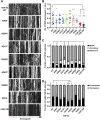
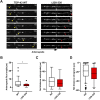
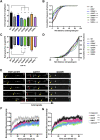

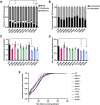


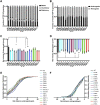
Similar articles
-
Phase separation and pathologic transitions of RNP condensates in neurons: implications for amyotrophic lateral sclerosis, frontotemporal dementia and other neurodegenerative disorders.Front Mol Neurosci. 2023 Sep 1;16:1242925. doi: 10.3389/fnmol.2023.1242925. eCollection 2023. Front Mol Neurosci. 2023. PMID: 37720552 Free PMC article. Review.
-
TAR DNA-binding protein 43 (TDP-43) liquid-liquid phase separation is mediated by just a few aromatic residues.J Biol Chem. 2018 Apr 20;293(16):6090-6098. doi: 10.1074/jbc.AC117.001037. Epub 2018 Mar 6. J Biol Chem. 2018. PMID: 29511089 Free PMC article.
-
Amyotrophic lateral sclerosis-linked mutations increase the viscosity of liquid-like TDP-43 RNP granules in neurons.Proc Natl Acad Sci U S A. 2017 Mar 21;114(12):E2466-E2475. doi: 10.1073/pnas.1614462114. Epub 2017 Mar 6. Proc Natl Acad Sci U S A. 2017. PMID: 28265061 Free PMC article.
-
Ataxin-2 polyglutamine expansions aberrantly sequester TDP-43 ribonucleoprotein condensates disrupting mRNA transport and local translation in neurons.Dev Cell. 2025 Jan 20;60(2):253-269.e5. doi: 10.1016/j.devcel.2024.09.023. Epub 2024 Oct 16. Dev Cell. 2025. PMID: 39419034
-
The implications of physiological biomolecular condensates in amyotrophic lateral sclerosis.Semin Cell Dev Biol. 2024 Mar 15;156:176-189. doi: 10.1016/j.semcdb.2023.05.006. Epub 2023 May 31. Semin Cell Dev Biol. 2024. PMID: 37268555 Review.
Cited by
-
Mutations in human prion-like domains: pathogenic but not always amyloidogenic.Prion. 2024 Dec;18(1):28-39. doi: 10.1080/19336896.2024.2329186. Epub 2024 Mar 21. Prion. 2024. PMID: 38512820 Free PMC article. Review.
-
Amyotrophic Lateral Sclerosis: Focus on Cytoplasmic Trafficking and Proteostasis.Mol Neurobiol. 2025 Aug;62(8):10091-10117. doi: 10.1007/s12035-025-04831-7. Epub 2025 Apr 3. Mol Neurobiol. 2025. PMID: 40180687 Free PMC article. Review.
-
Phase separation and pathologic transitions of RNP condensates in neurons: implications for amyotrophic lateral sclerosis, frontotemporal dementia and other neurodegenerative disorders.Front Mol Neurosci. 2023 Sep 1;16:1242925. doi: 10.3389/fnmol.2023.1242925. eCollection 2023. Front Mol Neurosci. 2023. PMID: 37720552 Free PMC article. Review.
-
Dynamical control enables the formation of demixed biomolecular condensates.Nat Commun. 2023 Nov 24;14(1):7678. doi: 10.1038/s41467-023-43489-4. Nat Commun. 2023. PMID: 37996438 Free PMC article.
-
Rational Design of TDP-43 Derived α-Helical Peptide Inhibitors: An In Silico Strategy to Prevent TDP-43 Aggregation in Neurodegenerative Disorders.ACS Chem Neurosci. 2024 Mar 20;15(6):1096-1109. doi: 10.1021/acschemneuro.3c00659. Epub 2024 Mar 11. ACS Chem Neurosci. 2024. PMID: 38466778 Free PMC article.
References
-
- Altman T., Ionescu A., Ibraheem A., Priesmann D., Gradus-Pery T., Farberov L., et al. (2021). Axonal TDP-43 Condensates Drive Neuromuscular Junction Disruption through Inhibition of Local Synthesis of Nuclear Encoded Mitochondrial Proteins. Nat. Commun. 12 (1), 6914. 10.1038/s41467-021-27221-8 - DOI - PMC - PubMed
Grants and funding
LinkOut - more resources
Full Text Sources
Miscellaneous

